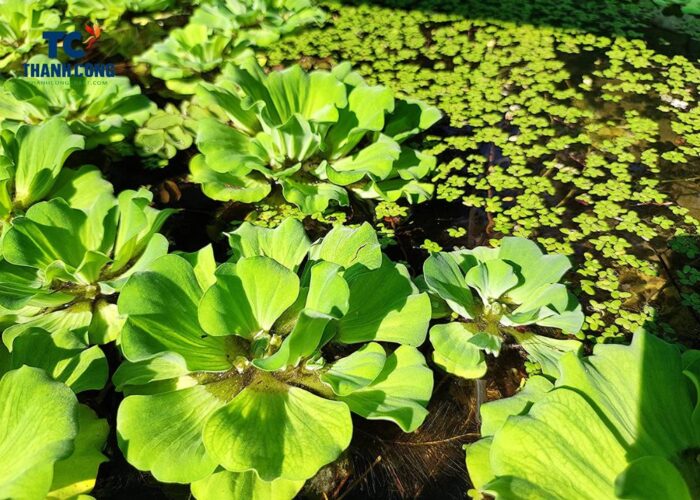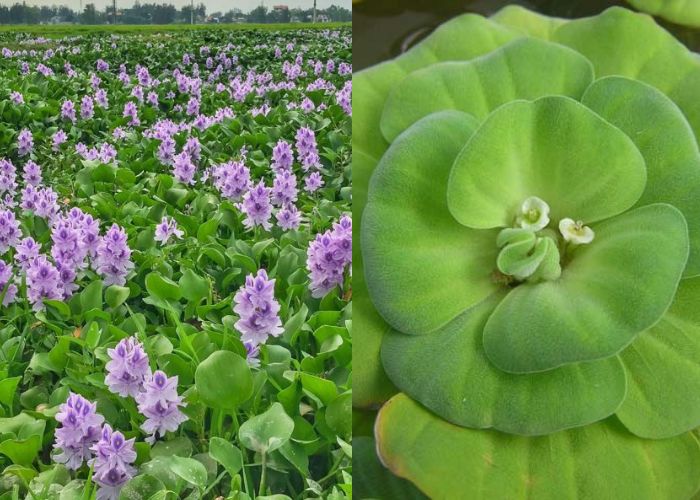Water lettuce and water hyacinth are two aquatic plants commonly found in ponds, lakes, and waterways around the world. While they may share a habitat and appear somewhat similar at first glance, these two aquatic plants are distinct in many ways. In this article, we will explore the question How different are Water Lettuce vs Water Hyacinth? in order to offer a comprehensive overview.
Contents [hide]
1. Lettuce plant
Water lettuce (pistia stratiotes), also known as water cabbage, is one of the floating pond plants with distinctive rosettes of leaves that resemble heads of lettuce. Its leaves feature deep ribs, parallel veins, and scalloped edges, with no prominent stems.
Water lettuce produces small, inconspicuous white or pale green flowers concealed within the foliage, typically blooming from late summer to late fall. Thriving in freshwater environments, water lettuce requires approximately 11 to 12 hours of full sunlight each day (or dappled light in high-temperature conditions).

Water lettuce serves as an effective natural purifier for pond water, aiding in the removal of decomposition byproducts and contributing to the overall health of fish and aquatic ecosystems. This plant plays a crucial role in reducing algae blooms by shading the water’s surface, thereby limiting sunlight penetration and competing for the nutrients required by algae to thrive.
While water lettuce is suitable for water gardens and provides refuge for small fish, it’s worth noting that larger fish such as koi, cichlids, and goldfish may occasionally graze on and potentially damage the plants.
2. Hyacinth plant
Water hyacinth, scientifically known as Eichhornia crassipes Solms, originates from South America. Water hyacinth has a remarkably fast reproductive rate, particularly in riverine areas. As a result, upon its introduction to Vietnam, this plant quickly spread throughout the country.
Water hyacinth is an aquatic perennial plant that thrives in water or wet environments. It can reach a height of about upto 90 cm. Its leaves are green, round, and smooth on one side. The leaf veins are long and narrow, often spiraling like the petals of a flower, and the leaf blades puff up like bubbles.

The irregular greenish-purple flowers have upper petals usually sporting a yellow spot with 6 stamens, consisting of 3 long and 3 short ones. The fruit is a capsule divided into 3 compartments, each containing numerous seeds. The root system of water hyacinth consists of long, black, hair-like structures that float beneath the water’s surface, resembling sharp hairs.
Water hyacinth is commonly cultivated in ponds, used as a aquarium plants in decorative fish tanks, employed for landscaping in ecological ponds, or planted in combination with other aquatic plants like lotus and water lilies to create water gardens and garden landscapes.
3. Water Lettuce and Water Hyacinth Benefits
Both water lettuce (Pistia stratiotes) and water hyacinth (Eichhornia crassipes) can be used for wastewater treatment due to their ability to absorb nutrients and pollutants from the water. They are often employed in a process known as phytoremediation, which utilizes aquatic plants to remove contaminants from water.
Water lettuce and water hyacinth are efficient at extracting excess nutrients, particularly nitrogen and phosphorus, from water. These nutrients can lead to water pollution and eutrophication if not properly managed. The plants absorb these nutrients, helping to reduce their levels in the water.
Morover, the extensive root systems of these plants provide a surface area for beneficial microorganisms to colonize. These microorganisms can break down and metabolize organic pollutants, further improving water quality.
4. Comparison: Water Lettuce vs Water Hyacinth
Water lettuce and water hyacinth are two common aquatic plants that can be used for ornamental or ecological purposes. They both have floating leaves and roots that hang in the water, but they differ in several aspects.
- Water lettuce has pale green, velvety leaves that form a rosette shape, while water hyacinth has glossy green, oval leaves and purple flowers.
- Water lettuce can tolerate colder temperatures and lower light levels than water hyacinth, which prefers warm and sunny conditions.
- Water hyacinth grows faster and produces more biomass than water lettuce, but it also consumes more nutrients and oxygen from the water.
- Both plants can become invasive if not controlled, but water hyacinth is considered more problematic because of its rapid spread and negative impacts on aquatic ecosystems.
In summary, while water lettuce and water hyacinth may appear similar in their aquatic habitat, they have significant differences in terms of growth form, invasiveness, leaf characteristics, and ecological impact.

We’ve explored the distinct characteristics and ecological roles of these two aquatic plants. How different are water lettuce vs water hyacinth? The answer lies in their taxonomy, growth forms, habitats, and impact on aquatic ecosystems.
If you have any further questions, don’t hesitate to send thanhcongcraft an email us at info@thanhcongcraft.com or message us at WhatsApp: +84967485411. Hope to serve you soon! Best regard!


